选修九 5.2《Unit 5 How advertising works》
- 格式:ppt
- 大小:1.37 MB
- 文档页数:34
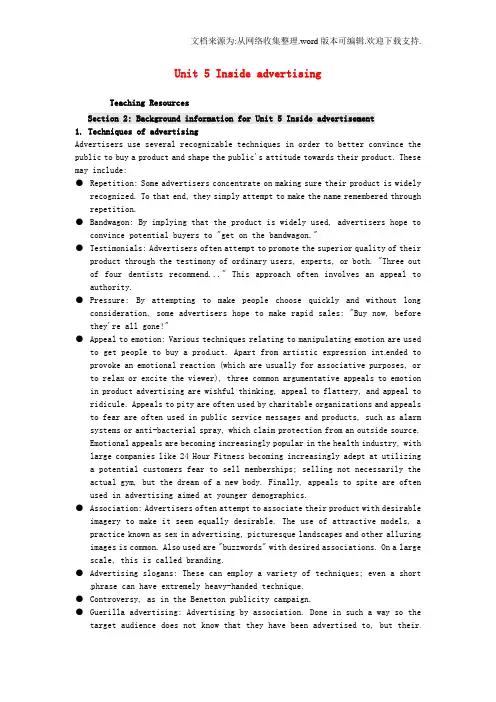
Unit 5 Inside advertisingTeaching ResourcesSection 2: Background information for Unit 5 Inside advertisement1. Techniques of advertisingAdvertisers use several recognizable techniques in order to better convince the public to buy a product and shape the public's attitude towards their product. These may include:●Repetition: Some advertisers concentrate on making sure their product is widelyrecognized. To that end, they simply attempt to make the name remembered through repetition.●Bandwagon: By implying that the product is widely used, advertisers hope toconvince potential buyers to "get on the bandwagon."●Testimonials: Advertisers often attempt to promote the superior quality of theirproduct through the testimony of ordinary users, experts, or both. "Three out of four dentists recommend..." This approach often involves an appeal to authority.●Pressure: By attempting to make people choose quickly and without longconsideration, some advertisers hope to make rapid sales: "Buy now, before they're all gone!"●Appeal to emotion: Various techniques relating to manipulating emotion are usedto get people to buy a prod uct. Apart from artistic expression int ended to provoke an emotional reaction (which are usually for associative purposes, or to relax or excite the viewer), three common argumentative appeals to emotion in product advertising are wishful thinking, appeal to flattery, and appeal to ridicule. Appeals to pity are often used by charitable organizations and appeals to fear are often used in public service messages and products, such as alarm systems or anti-bacterial spray, which claim protection from an outside source.Emotional appeals are becoming increasingly popular in the health industry, with large companies like 24 Hour Fitness becoming increasingly adept at utilizinga potential customers fear to sell memberships; selling not necessarily theactual gym, but the dream of a new body. Finally, appeals to spite are often used in advertising aimed at younger demographics.●Association: Advertisers often attempt to associate their product with desirableimagery to make it seem equally desirable. The use of attractive models, a practice known as sex in advertising, picturesque landscapes and other alluring images is common. Also used are "buzzwords" with desired associations. On a large scale, this is called branding.●Advertising slogans: These can employ a variety of techniques; even a shortphrase can have extremely heavy-handed technique.●Controversy, as in the Benetton publicity campaign.●Guerilla advertising: Advertising by association. Done in such a way so thetarget audience does not know that they have been advertised to, but theirimpression of the product is increased (or decreased) if that is the intent of the advertiser.●Subliminal messages: It was feared that some advertisements would present hiddenmessages, for example through brief flashed messages or the soundtrack, that would have a hypnotic effect on viewers ('Must buy car. Must buy car.') The notion that techniques of hypnosis are used by advertisers is now generally discredited, though sublimin al sexual messages are extremely common, ranging from car models with SX prefixes to suggestive positioning of objects in magazine ads and billboards.2.Advertising Research Tips●Perceptual Mapping -- Deciding What Image to ProjectBefore you embark on an image advertising campaign, you need to know the type of image you wish to convey.●Quick & Dirty Research Techniques - Part 1Measuring the cost effectiveness of advertising promotions.●Quick & Dirty Research Techniques - Part 2Price-point testing.●Danger -- Comparative AdvertisingIncluding Your Competitors' Names in Your Advertising Can Be Counterproductive.●The Role of Focus Groups in AdvertisingFocus groups are a great tool for advertising research, but they should not be used to the exclusion of quantitative research.●How Research Can Drive the Advertising Mediums You UseTo choose the right advertising medium, you need to know who your customers and target customers are.●Allocating Advertising Dollars for Advertising ResearchHow much should you allocate to measure the communications effe ctiveness of your ads?●Is Your Advertising Working as Hard as it Could?Increase sales and speed up the "advertisement perfection" process through advertisin g testing.3.Advertising tipsBelow are some tips to consider when you would like to use advertisements:●Think outside the square - there are a variety of ways to get the attention of your audience by standard (eg press ad) and creative (eg spruiking in Rundle Mall) means.●When considering your adverti sing options put yourself in the shoes of your audience. For example if you want to reach the attention of males 18 plus during June you could look at running ads on 5AA during the KG & Cornes segment and further support this by placing ads in the Sports section of Saturday's Advertiser.●Forward planning is critical. To secure the best available spots on radio or in press, booking ahead is essential.●Consider your return on investment - to effective ly get your advertising message to your audience you may need to place a series of ads across a variety of media.Placing a solitary ad in the newspaper may not elicit a strong response.●Keep your message simple and ensure your call to action is clear. What is the most important part you'd like your audience to read or hear and how would you like them to respond? This should form the basis of your ad/s in terms of content, look and feel.●When you are about to embark on an advertising campaign, take note of ads that appeal to you or encourage people who are representative of your audience to provide you with feedback about the type of advertising they would find most effective ... the look and feel of an ad can be just as important as the message itself.4. Marketing strategiesStrategy serves as the foundation of a marketing plan. A marketing plan contains a list of specific actions required to successfully implement a specific marketing strategy. An example of mark eting strategy is as follows: "Use a low cost product to attract consumers. Once our organization, via our low cost product, has established a relationship with consumers, our organization will sell additional, higher-margin products and services that enhance the consumer's interaction with the low-cost product or service."A strategy is different than a tactic. While it is possible to write a tactical marketing plan without a sound, well-considered strategy, it is not recommended. Without a sound marketing strategy, a marketing plan has no foundation. Marketing strategies serve as the fundamental underpinning of marketing plans designed to reach marketing objectives. It is important that these objectives have measurable results.A good marketing strategy should integrate an organization’s marketing goals, policies, and action sequences (tactics) into a cohesive whole. The objective of a marketing strategy is to provide a foundation from which a tactical plan is developed. This allows the organization to carry out its mission effectively and efficiently.Marketing strategies are partially derived from broader corporate strategies, corporate missions, and corporate goals. They should flow from the firm's mission statement. They are also influenced by a range of microenvironmental factors. Marketing strategies are dynamic and interactive. They are partially planned and partially unplanned.。
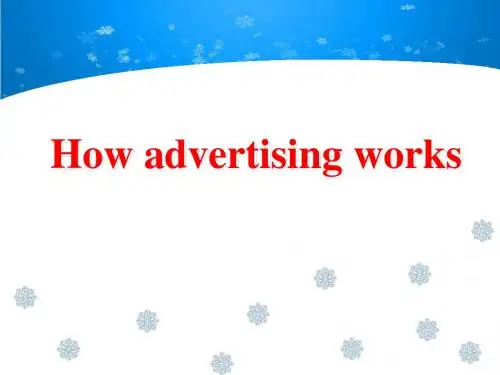
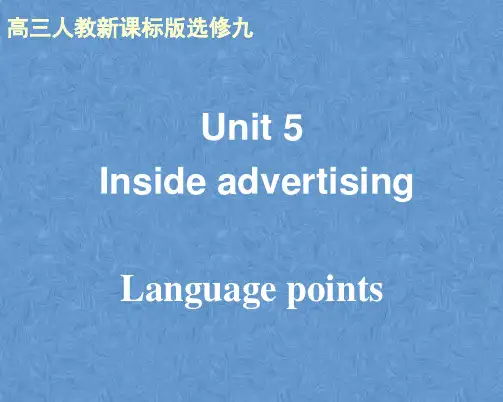
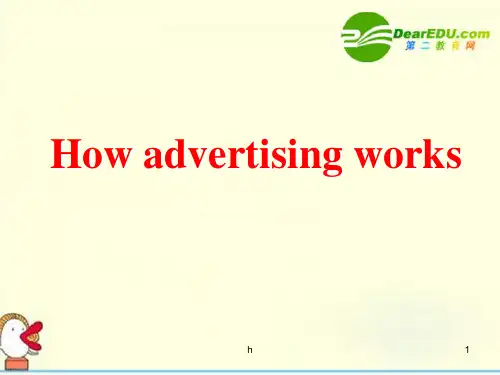
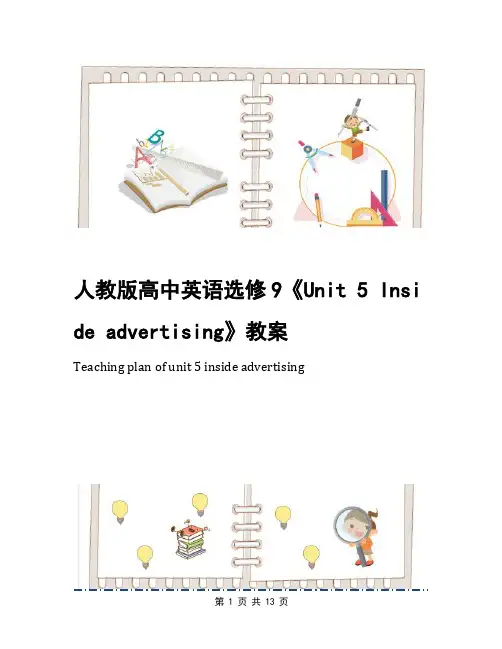
人教版高中英语选修9《Unit 5 Insi de advertising》教案Teaching plan of unit 5 inside advertising人教版高中英语选修9《Unit 5 Inside advertising》教案前言:英语作为在许多国际组织或者会议上都是必需语言,几乎所有学校选择英语作为其主要或唯一的外语必修课。
英语教学涉及多种专业理论知识,包括语言学、第二语言习得、词汇学、句法学、文体学、语料库理论、认知心理学等内容。
本教案根据英语课程标准的要求和教学对象的特点,将教学诸要素有序安排,确定合适的教学方案的设想和计划、并以启迪发展学生智力为根本目的。
便于学习和使用,本文档下载后内容可按需编辑修改及打印。
教学准备教学目标Teaching aims: (教学目标)1.To comprehend the passage and improve the reading skills.2.To express different views of an argument.3.To learn about how advertisements work and avoid being controlled by ads.教学重难点Important points:(重点、难点)prehension of the text.2.Knowledge accumulation of advertising.eful words and expressions.教学过程Teaching procedure:(教学过程)I. Warming upPlease enjoy a video and some pictures and answer some questions.1.Can you remember the names of any products that were being advertised? If so, why does this ad appeal to you more?2.What are the features(特征) of ads?3.Where can you see ads?设计意图:通过给学生展示一些广告视频和图片,激发学生对广告运作的兴趣,同时激发学生对相关词汇的回忆,从而为学习课文打好铺垫。
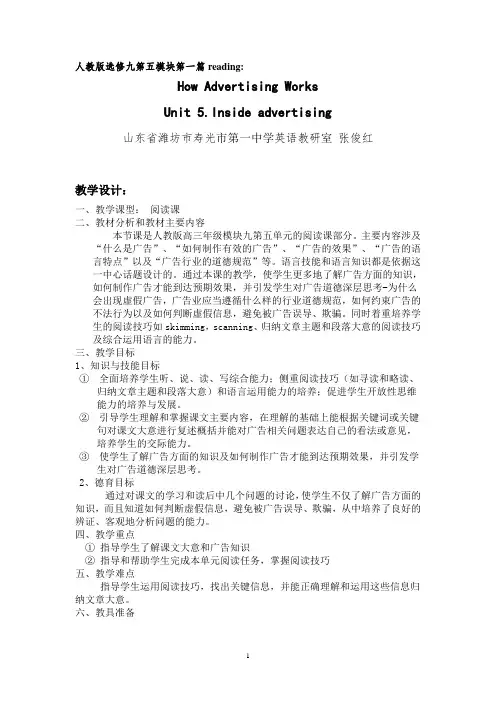
人教版选修九第五模块第一篇reading:How Advertising WorksUnit 5.Inside advertising山东省潍坊市寿光市第一中学英语教研室张俊红教学设计:一、教学课型:阅读课二、教材分析和教材主要内容本节课是人教版高三年级模块九第五单元的阅读课部分。
主要内容涉及“什么是广告”、“如何制作有效的广告”、“广告的效果”、“广告的语言特点”以及“广告行业的道德规范”等。
语言技能和语言知识都是依据这一中心话题设计的。
通过本课的教学,使学生更多地了解广告方面的知识,如何制作广告才能到达预期效果,并引发学生对广告道德深层思考-为什么会出现虚假广告,广告业应当遵循什么样的行业道德规范,如何约束广告的不法行为以及如何判断虚假信息,避免被广告误导、欺骗。
同时着重培养学生的阅读技巧如skimming,scanning、归纳文章主题和段落大意的阅读技巧及综合运用语言的能力。
三、教学目标1、知识与技能目标①全面培养学生听、说、读、写综合能力;侧重阅读技巧(如寻读和略读、归纳文章主题和段落大意)和语言运用能力的培养;促进学生开放性思维能力的培养与发展。
②引导学生理解和掌握课文主要内容,在理解的基础上能根据关键词或关键句对课文大意进行复述概括并能对广告相关问题表达自己的看法或意见,培养学生的交际能力。
③使学生了解广告方面的知识及如何制作广告才能到达预期效果,并引发学生对广告道德深层思考。
2、德育目标通过对课文的学习和读后中几个问题的讨论,使学生不仅了解广告方面的知识,而且知道如何判断虚假信息,避免被广告误导、欺骗,从中培养了良好的辨证、客观地分析问题的能力。
四、教学重点①指导学生了解课文大意和广告知识②指导和帮助学生完成本单元阅读任务,掌握阅读技巧五、教学难点指导学生运用阅读技巧,找出关键信息,并能正确理解和运用这些信息归纳文章大意。
六、教具准备以多媒体辅助教学为主,板书关键词、句为辅。
需要准备一台电脑和一块黑板。

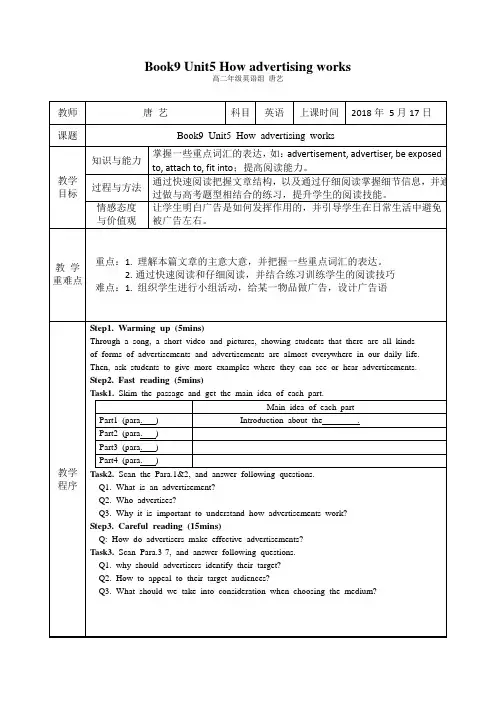
Book9 Unit5 How advertising works高二年级英语组唐艺教师唐艺科目英语上课时间2018年5月17日课题Book9 Unit5 How advertising works教学目标知识与能力掌握一些重点词汇的表达,如:advertisement, advertiser, be exposedto, attach to, fit into;提高阅读能力。
过程与方法通过快速阅读把握文章结构,以及通过仔细阅读掌握细节信息,并通过做与高考题型相结合的练习,提升学生的阅读技能。
情感态度与价值观让学生明白广告是如何发挥作用的,并引导学生在日常生活中避免被广告左右。
教学重难点重点:1. 理解本篇文章的主意大意,并把握一些重点词汇的表达。
2.通过快速阅读和仔细阅读,并结合练习训练学生的阅读技巧难点:1. 组织学生进行小组活动,给某一物品做广告,设计广告语教学程序Step1. Warming up (5mins)Through a song, a short video and pictures, showing students that there are all kinds of forms of advertisements and advertisements are almost everywhere in our daily life. Then, ask students to give more examples where they can see or hear advertisements. Step2. Fast reading (5mins)Task1.Skim the passage and get the main idea of each part.Main idea of each partPart1 (para. ) Introduction about the .Part2 (para. )Part3 (para. )Part4 (para. )Task2.Scan the Para.1&2, and answer following questions.Q1. What is an advertisement?Q2. Who advertises?Q3. Why it is important to understand how advertisements work?Step3. Careful reading (15mins)Q: How do advertisers make effective advertisements?Task3.Scan Para.3-7, and answer following questions.Q1. why should advertisers identify their target?Q2. How to appeal to their target audiences?Q3. What should we take into consideration when choosing the medium?Q: Who are their target audience(目标群体)?Q: Who are their target audience(目标群体)?Task4. choose the best answer.1. Which advertisement is to educate the pubilc ?2.The advertisement on the right probably appeals to people’s .A. conscience to be worthy citizensB. hopes to live an exciting lifeC. curiosity to know more about the productD. focus on the rich and famous people3. Which of the following is NOT the factor in choosing the right medium?A. Whether the budget(预算)can be afforded.B. Which target audience the products are intended for.C. Which medium can best display the products.D. How to advertise the products with the right technique.4. What does the word “conscience” in paragrapg 5 probably mean?A. conditionB. requirementC. inner peaceD. moral sense5. The purpose of this text is to .A. inform people of the functions of advertisementsB. persuade people to buy the products advertised by some advertisementsC. Let people understand how advertisements work so as not to be controlled by them.D. warn people not to be cheated by some dishonest advertisementsTask5.Scan Para.8-9, and judge True or False.1.However good an advertisement is, people are likely to be persuaded if the product is unsuitable for them.2. The reason why governments all over the world pay a lot of ads on such things as road satey is that they believe these adverts will affect the way people think about their driving habits and will subsequently reduce the number of road accidents.Step4. Group work (10mins)After learning about how advertising works, can you advertise something?Step5. ConclusionIt's important to understand how advertisements work, and then we canavoid being control by them.Step6. HomeworkDo exercises on Shi Ji Jin Bang P34 - P36. Step7. Blackboard design Unit 5 Inside advertsingReadingHow advertisingworks?What is an advertisement?How do advertisers makeeffective advertisement?How effective are advertisement。
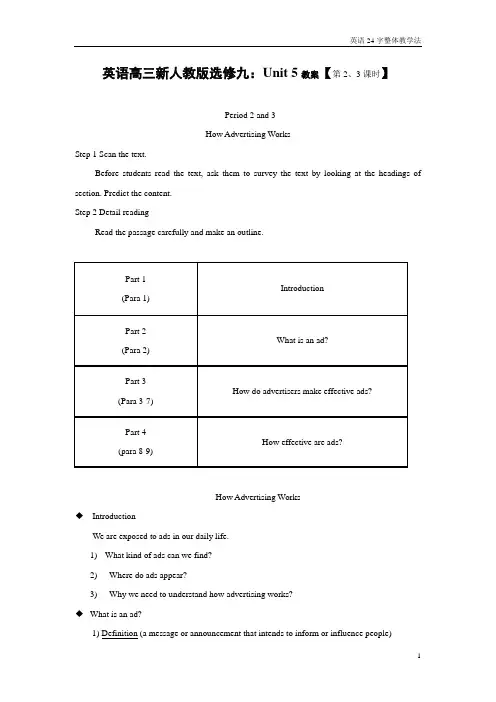
英语高三新人教版选修九:Unit 5教案【第2、3课时】Period 2 and 3How Advertising WorksStep 1 Scan the text.Before students read the text, ask them to survey the text by looking at the headings of section. Predict the content.Step 2 Detail readingRead the passage carefully and make an outline.How Advertising Works◆IntroductionWe are exposed to ads in our daily life.1)What kind of ads can we find?2)Where do ads appear?3)Why we need to understand how advertising works?◆What is an ad?1) Definition (a message or announcement that intends to inform or influence people)2) Means (words, pictures, music, film…)3) Advertisers (business, individuals, organizations, associations)◆How do advertisers make effective ads?1) Identify the target (find out necessary information about this group)2) Appeal to the target (hopes, dreams, emotions, desires…)3) Use a suitable medium (cost, media)◆How effective are ads?1) When there is a need for the product2) If the target audience is exposed to ads constantlyStep 3 Language pointsStep 4 HomeworkMake up an advertisement for a product (including a slogan, the spokesman/spokeswoman and the whole procedure.*******************全单元教学要求概论************Unit 5 Inside advertisingTeaching aims and demands。

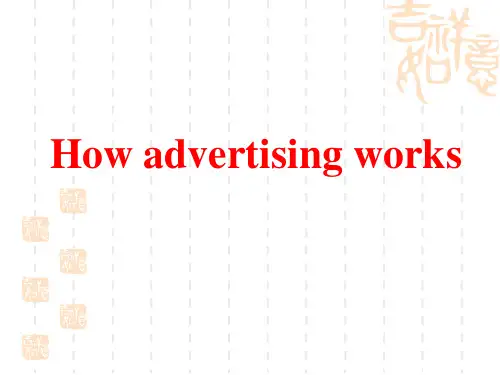
Book 9, Unit 5, How Advertising Works导学案(教师版)一、本单元授课范围、知识点、重点、难点、易错点1.授课范围:Book 9, Unit 5, How Advertising Works2.知识点:(1) Important words:billboard, advertiser, advert, lane, feature, conscience, worthy, corporation, expense, generate, response, stereo. Partly, sheet, spokesman, litre, mature, fashion, dishonest, alcoholic, tobacco, promote, immoral, decent, ethics, ethical, offending, beware, consumer, trustworthy(2) Important phrases:turn…into, fit…into, rely on, have no use for, make sense, hand over, keep inmind, be worthy of, be exposed to, be great for doing sth., be flooded with,in response to, raise the money, inform sb. of sth., keep sb. Informed, over time (3) Useful sentences:1. (Para. 1 of P42) Even some of the casual garments we wear have brand names attached to them which turn us into walking advertisements.2. (Para.3,of P42) Their money would be wasted if the message didn’t reach its target audience, in other words the people the advertisement intends to persuade.3. (Para. 3 of P43) However, it would be no use advertising products on radio if the ad relies on visual effects.4. (Para. 3 of P49) When it comes to advertising, consumers need to be educated about techniques used by advertisers so they can judge the claims for themselves and not blindly accept everything that is said in advertisements.5. (Para. 3 of P49) As we are flooded with advertisements in our modern world, many schools believe it is their duty to educate students about advertising.(4)Confusing points:1) be exposed to; expose sth. /oneself to sth.2) fit into/in3) basis; base4) worth, worthy,和worthwhile(5)Grammar:复习宾语补足语(The Object Complement)二、如何强化重点(具体策略)策略一:通过词汇拓展掌握本单元的重点单词,并达到扩大词汇量的目的。